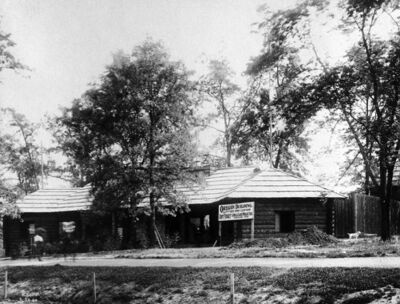Oregon
 | |
| Location | Plateau of States |
|---|---|
| Construction | |
| Construction Cost | $5,000 ($150,796 in 2021) |
| Architecture | |
| Architect | Widden & Lewis, of Portland |
| Dimensions | 60' x 90' |
Oregon's entry on the Plateau of States was a reproduction of the buildings and stockade used by Lewis and Clark in the winter of 1805-06, known in history as Fort Clatsop. This fort was built by the explorers' party at the mouth of the Columbia river on the territory of the Clatsop Indians. It was the first building constructed in the Oregon country on the Pacific coast by European Americans, one story high and irregular in form.
Description[edit | edit source]
The evergreens and rhododendrons in front were brought from near the snow line of the Oregon mountains.
The outer rough bark walls were of logs split lengthwise. The other halves of them are out there in the hundred-foot square stockade. At the corners of this stockade, looking down on the sharpened points of the great logs set on end, are two small block houses.
In the main room the rough finish of the original is preserved. The floor is of rough boards, and the draperies of Indian blankets. A great fireplace, eight feet across, will take a yule log which two horses can hardly drag. The furniture is of bent hickory with the bark still on.
The one modern touch is the Conover piano.
The interior finish is in beautiful native woods—fir, pine, larch, spruce and cedar. A stairway gives access to a cozy little roof garden, which in the original was perhaps a vantage point from which a sentinel scanned the horizon looking for hostiles. The smaller rooms are used for offices, reception and rest rooms.
In one is a relief map, showing the route taken by Lewis and Clark, the great Mormon trail, and the immigrant trail through the American desert.
The building included a 600-seat restaurant.
In the Horticultural Building about 50 exhibitors displayed specimens of the fruits of Oregon. Apples, pears, and prunes were shown in interesting variety and unexcelled quality.
In the Mines and Metallurgy Palace, there was a very unique and interesting display of mineral specimens, many of which were loaned to the State of Oregon for use at the exposition. Among the specimens there were collections of gold quartz and nuggets from the various gold mines of the State. Besides the gold, there were shown collections of polished pebble, copper ores, native silver, including cobalt and antimony ores, crystals, opals, marble, jasper, asbestos, limestone, kaolin, asphaltum, and tellurium ores.
There were also displayed Indian curios.
Oregon's display at the Palaces of Agriculture, and Forestry, Fish and Game were also noteworthy.
